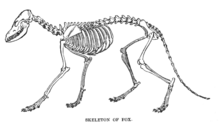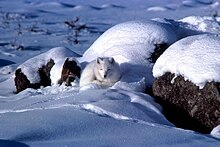Rubah
| Rubah | ||||||||||||
|---|---|---|---|---|---|---|---|---|---|---|---|---|
 Rubah merah (Vulpes vulpes)
| ||||||||||||
| Pengelasan saintifik | ||||||||||||
|
Rubah (Jawi: روبه) juga disebut sebagai musang (Musang anjing) di Malaysia ialah mamalia omnivor bersaiz kecil hingga sederhana yang tergolong dalam beberapa genus keluarga Canidae. Mereka mempunyai tengkorak yang rata, telinga segi tiga tegak, muncung runcing dan sedikit terbalik, dan ekor yang panjang dan lebat.
Rubah tersebar di semua benua kecuali Antartika. Spesies rubah yang paling meluas adalah rubah merah (Vulpes vulpes) dengan kira-kira 47 subspesies dikenalpasti.[1]
Nama[sunting | sunting sumber]
Masyarakat Cina biasanya mengelar Fox (Rubah) sebagai "Musang Rubah" 狐狸 (Huli) , hanya komuniti saintis yang biasa menggunakan "Rubah" 狐 (Hu). Oleh itu didalam Bahasa Melayu juga disebut musang akibat terjemahan daripada Bahasa Cina
Untuk Musang(Musang Kucing) pulak, masyarakat umum Cina biasanya menggunakan "Kucing Musang", serupa dengan penggunaan "Civet Cat" dalam Bahasa Inggeris, oleh itu Kopi Luwak adakalanya digelar "Kopi Tahi kucing" oleh masyarakat Cina
Morfologi umum[sunting | sunting sumber]

Rubah secara umumnya lebih kecil dari beberapa anggota keluarga Canidae seperti serigala dan jakal, sementara boleh lebih besar daripada beberapa anggota lain dalam keluarga ini seperti anjing rakun. Spesies terbesar, rubah merah, yang jantan mempunyai berat purata antara 4.1 dan 8.7 kilogram (9 dan 19 1⁄4 paun),[2] manakala spesies terkecil, rubah fanak, ditimbang setakat 0.7 hingga 1.6 kg (1 1⁄2 hingga 3 1⁄2 lb).[3]
Fox features typically include a triangular face, pointed ears, an elongated rostrum, and a bushy tail. They are digitigrade (meaning they walk on their toes). Unlike most members of the family Canidae, foxes have partially retractable claws.[4] Fox vibrissae, or whiskers, are black. The whiskers on the muzzle, known as mystacial vibrissae, average 100–110 milimeter (3 7⁄8–4 3⁄8 inci) long, while the whiskers everywhere else on the head average to be shorter in length. Whiskers (carpal vibrissae) are also on the forelimbs and average 40 mm (1 5⁄8 in) long, pointing downward and backward.[1] Other physical characteristics vary according to habitat and adaptive significance.
Pelage[sunting | sunting sumber]
Fox species differ in fur color, length, and density. Coat colors range from pearly white to black-and-white to black flecked with white or grey on the underside. Fennec foxes (and other species of fox adapted to life in the desert, such as kit foxes), for example, have large ears and short fur to aid in keeping the body cool.[1][4] Arctic foxes, on the other hand, have tiny ears and short limbs as well as thick, insulating fur, which aid in keeping the body warm.[5] Red foxes, by contrast, have a typical auburn pelt, the tail normally ending with a white marking.[6]
A fox's coat color and texture may vary due to the change in seasons; fox pelts are richer and denser in the colder months and lighter in the warmer months. To get rid of the dense winter coat, foxes moult once a year around April; the process begins from the feet, up the legs, and then along the back.[4] Coat color may also change as the individual ages.[1]
Dentition[sunting | sunting sumber]
A fox's dentition, like all other canids, is I 3/3, C 1/1, PM 4/4, M 3/2 = 42. (Bat-eared foxes have six extra molars, totalling in 48 teeth.) Foxes have pronounced carnassial pairs, which is characteristic of a carnivore. These pairs consist of the upper premolar and the lower first molar, and work together to shear tough material like flesh. Foxes' canines are pronounced, also characteristic of a carnivore, and are excellent in gripping prey.[7]
Tabiat[sunting | sunting sumber]

Jangka hayat biasa seekor rubah adalah selama satu hingga 3 tahun sungguhpun ada individu yang mampu hidup sehingga sepuluh tahun. Tidak seperti banyak kanid, rubah tidak selalunya berkawan-kawanan. Rubah hidup berkeluarga kecil, tetapi ada juga rubah tertentu ang hidup bersendirian (seperti rubah Artik).[1][4]
Rubah haiwan jenis omnivor.[8][9] Pemakanan utamanya terdiri daripada invertebrata seperti serangga dan vertebrata kecil seperti reptilia dan burung. Rubah juga akan makan telur dan tumbuh-tumbuhan. Many species are generalist predators, but some (such as the crab-eating fox) have more specialized diets. Most species of fox consume around 1 kg (2.2 lb) of food every day. Foxes cache excess food, burying it for later consumption, usually under leaves, snow, or soil.[4][10] While hunting, foxes tend to use a particular pouncing technique, such that they crouch down to camouflage themselves in the terrain and then use their hind legs to leap up with great force and land on top of their chosen prey.[1] Using their pronounced canine teeth, they can then grip the prey's neck and shake it until it is dead or can be readily disemboweled.[1]
Rubah kelabu diketahui kerap memanjat pokok.[11]
Sexual characteristics[sunting | sunting sumber]
The male fox's scrotum is held up close to the body with the testes inside even after they descend. Like other canines, the male fox has a baculum, or penile bone.[1][12][13] The testes of red foxes are smaller than those of Arctic foxes.[14] Sperm formation in red foxes begins in August–September, with the testicles attaining their greatest weight in December–February.[15]
Vixens are in heat for one to six days, making their reproductive cycle twelve months long. As with other canines, the ova are shed during estrus without the need for the stimulation of copulating. Once the egg is fertilized, the vixen enters a period of gestation that can last from 52 to 53 days. Foxes tend to have an average litter size of four to five with an 80 percent success rate in becoming pregnant.[1][16] Litter sizes can vary greatly according to species and environment – the Arctic fox, for example, can have up to eleven kits.[17]
The vixen usually has six or eight mammae.[18] Each teat has 8 to 20 lactiferous ducts, which connect the mammary gland to the nipple, allowing for milk to be carried to the nipple.[perlu rujukan]
Vocalization[sunting | sunting sumber]
The fox's vocal repertoire is vast, and includes:
- Whine – Made shortly after birth. Occurs at a high rate when kits are hungry and when their body temperatures are low. Whining stimulates the mother to care for her young; it also has been known to stimulate the male fox into caring for his mate and kits.
- Yelp – Made about 19 days later. The kits' whining turns into infantile barks, yelps, which occur heavily during play.
- Explosive call – At the age of about one month, the kits can emit an explosive call which is intended to be threatening to intruders or other cubs; a high-pitched howl.
- Combative call – In adults, the explosive call becomes an open-mouthed combative call during any conflict; a sharper bark.
- Growl – An adult fox's indication to their kits to feed or head to the adult's location.
- Bark – Adult foxes warn against intruders and in defense by barking.[1][19]
In the case of domesticated foxes, the whining seems to remain in adult individuals as a sign of excitement and submission in the presence of their owners.[1]
Rujukan[sunting | sunting sumber]
- ^ a b c d e f g h i j k Lloyd, H.G. (1981). The red fox (ed. 2. impr.). London: Batsford. m/s. 21. ISBN 978-0-7134-11904.
- ^ Larivière, S.; Pasitschniak-Arts, M. (1996). "Vulpes vulpes". Mammalian Species (537): 1–11. doi:10.2307/3504236. JSTOR 3504236.
- ^ Nobleman, Marc Tyler (2007). Foxes. Benchmark Books (NY). m/s. 35–36. ISBN 978-0-7614-2237-2.
- ^ a b c d e Burrows, Roger (1968). Wild fox. Newton Abbot: David & Charles. ISBN 9780715342176.
- ^ "Arctic fox (Vulpes lagopus)". ARKive. Diarkibkan daripada yang asal pada 2014-10-06. Dicapai pada 2 October 2014.
- ^ Fox, David. "Vulpes vulpes, red fox". Animal Diversity Web. Dicapai pada 2 October 2014.
- ^ "Canidae". The University of Edinburgh. Dicapai pada 23 September 2014.
- ^ Fedriani, J.M.; T. K. Fuller; R. M. Sauvajot; E. C. York (5 Julai 2000). "Competition and intraguild predation among three sympatric carnivores" (PDF). Oecologia. 125 (2): 258–270. Bibcode:2000Oecol.125..258F. doi:10.1007/s004420000448. hdl:10261/54628. PMID 24595837. S2CID 24289407. Diarkibkan daripada yang asal (PDF) pada 2011-10-06.
- ^ Fox, David L. (2007). "Vulpes vulpes (red fox)". Animal Diversity Web. University of Michigan Museum of Zoology.
- ^ Macdonald, David W. (26 April 2010). "Food Caching by Red Foxes and Some Other Carnivores". Zeitschrift für Tierpsychologie. 42 (2): 170–185. doi:10.1111/j.1439-0310.1976.tb00963.x. PMID 1007654.
- ^ Lavigne, Guillaume de (19 Mac 2015). Free Ranging Dogs – Stray, Feral or Wild? (dalam bahasa Inggeris). Lulu Press, Inc. ISBN 9781326219529.
- ^ Čanády, Alexander. "Variability of the baculum in the red fox (Vulpes vulpes) from Slovakia." Zoology and Ecology 23.3 (2013): 165–170.
- ^ Bijlsma, Rob G. "Copulatory lock of wild red fox (Vulpes vulpes) in broad daylight." Naturalist 80: 45–67.
- ^ Heptner & Naumov 1998, halaman 341
- ^ Heptner & Naumov 1998, halaman 537
- ^ Parkes, I. W. Rowlands and A. S. (21 August 2009). "The Reproductive Processes of certain Mammals.-VIII. Reproduction in Foxes (Vulpes spp.)". Proceedings of the Zoological Society of London. 105 (4): 823–841. doi:10.1111/j.1469-7998.1935.tb06267.x.
- ^ Hildebrand, Milton (1952). "The Integument in Canidae". Journal of Mammalogy. 33 (4): 419–428. doi:10.2307/1376014. JSTOR 1376014.
- ^ Ronald M. Nowak (2005). Walker's Carnivores of the World. JHU Press. ISBN 978-0-8018-8032-2.
- ^ Tembrock, Günter (1976). "Canid vocalizations". Behavioural Processes. 1 (1): 57–75. doi:10.1016/0376-6357(76)90007-3. PMID 24923545. S2CID 205107627.
